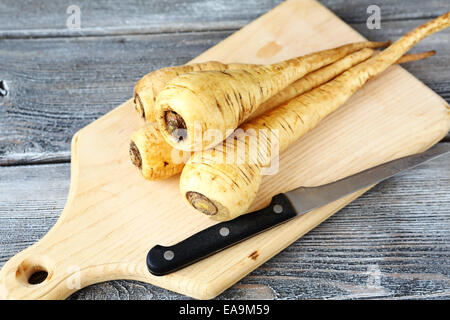

Saute – slice and place in a skillet with butter, salt, and pepper. Roast cut parsnips with other root vegetables. Turn regularly when grilling or roasting. Roast/Grill – cut into halves, quarters, or thick slices lengthwise, toss with olive oil, salt, pepper and thyme, and roast at 450☏ for 20-30 minutes or grill over medium heat until caramelized and tender. Slice or matchstick (cut into long sticks similar to carrots) the parsnip and use it as a dipping vegetable with hummus or ranch. Raw – grate or shave parsnip on a box grater and add to salads or slaws.
RAW PARSNIPS SKIN
If you peel parsnips, be careful not to remove too much of the skin as you will remove most of the vitamins and minerals. Once clean, use parsnips unpeeled or peeled, and sliced, chopped, cubed, or whole. Once you just have the root, remove the gloves and scrub the parsnips with a stiff vegetable brush under cool running water to remove any remaining soil and tiny roots. Preparation – although it is rare to find parsnips with any part of their greens still attached, if you do, put on gloves and remove the shoots/stems and leaves before continuing with preparation. Sweet Potato Parsnip Bisque | Curried Parsnip & Carrot Soup | Roasted Parsnips | Mashed Parsnips with Crispy Pancetta This prevents the parsnip from freezing in a solid chunk and allows the parsnip to be easily thawed. Once the chunks have frozen, pack them into an air-tight container or freezer bag. Drain the chunks of parsnip, let them dry, spread them out on a baking sheet, and put in the freezer. To freeze parsnips, blanch 1-inch chunks in boiling water for 2-3 minutes and then immediately run under cold water or put in an ice bath to stop the cooking process. For longer-term storage, parsnips can be buried in moist sand and kept in a cool, but not freezing, location. To store parsnips, trim off the tops, if not yet trimmed, and refrigerate unwashed in a plastic bag for up to 2 weeks. Large brown or soft spots should be avoided, though they can easily be cut around making the rest of the parsnip usable. This prevents consumers from coming into contact with the phototoxic sap, and allows the parsnips to be stored longer. Parsnips are typically sold with their greens removed. Most of the vitamins are found close to the skin so finely peeling or cooking whole is suggested to avoid decreasing nutritional value.

Parsnips are rich in vitamins and minerals including several B-group vitamins, vitamin C, vitamin K, manganese and phosphorus, and are a particularly good source of potassium. Parsnips were originally used as a sweetener in Europe before beet and cane sugar became available, and served as the main cultivated starch of the Thirteen British Colonies until it was replaced by the potato. Parsnips are biennials, typically living for two years, although tend to be grown as annuals and harvested in the first year.


 0 kommentar(er)
0 kommentar(er)
